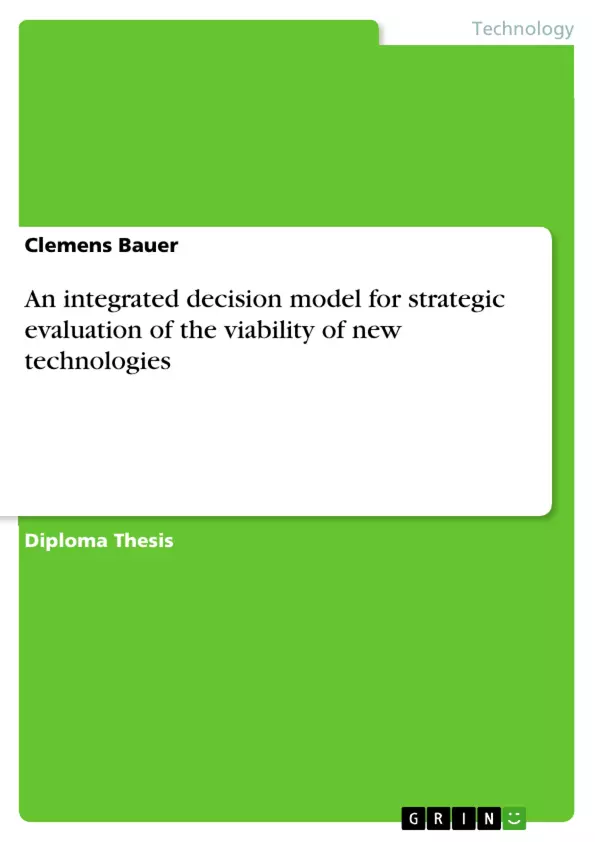This project is a continuation of the Total Technology Development (TTD) Framework which has been derived by Schulz (1998). The TTD is divided into four phases:
a) Integrated Technology Strategy (Defining next generation technologies)
b) Concept Generation and Enhancement (Overcoming psychological inertia)
c) Robustness Development and Analysis
d) Technology Selection, Transfer and Integration
The Integrated Decision Model (IDM) is partially going on with the ideas of the phases a), b) and d) of the TTD. It proposes and derives new methodologies for the evaluation and selection of new concepts. Furthermore, it considers – in contrast to the TTD – the development process as a continuous process which has to be evaluated continuously as well. That is, the attributes and influencing factors of the concepts are often changing during the development process which makes competing concepts possibly more valuable and attractive for the developer or changes the value of the concept to be developed.
Improvement in standards of living depend to a remarkable degree on the success of industrial innovations, but the odds of any one idea becoming an economic success are so low that many ideas are needed.
Inhaltsverzeichnis (Table of Contents)
- WORDS AHEAD.
- ACKNOWLEDGMENTS.
- THE CIPD AND ITS OBJECTIVES
- GUIDE TO THE THESIS.
- INTRODUCTION..
- CHANGED MARKETS AND BUSINESS ENVIRONMENT
- PROBLEMS WITHIN PRODUCT- AND TECHNOLOGY DEVELOPMENT
- OBJECTIVES OF THIS PROJECT
- ESSENTIALS OF SUCCESSFUL PRODUCT- AND TECHNOLOGY SELECTION
- APPROACH WITHIN THIS PROJECT..
- THE DECISION FRAMEWORK................
- AIM OF THE MODEL
- BLOCK 1 TO 3 IN SHORT
- TECHNOLOGY MODEL
- INTRODUCTION
- Questions to be answered..
- WHAT IS TECHNOLOGICAL CAPABILITY?
- Determine the expected and actual level of invention associated with the technology.
- Firm's performance relative to competition and technology limits….….…………………………......
- WHAT DOES TECHNOLOGICAL CAPABILITY NEED TO BE?
- Problem Identification and Formulation.
- Identify and Evaluate Future Opportunities.
- Prioritization and Sequencing of Problems and Opportunities....
- WHAT TECHNOLOGIES WILL BE PURSUED TO ENABLE THIS CAPABILITY?
- Creation of list of superior solution concepts and technologies.….…........
- Determination of ideality and risk associated with concept technologies.....
- Narrow the candidate list..
- MARKET MODEL
- INTRODUCTION
- MULTI-ATTRIBUTE UTILITY ANALYSIS
- CONJOINT ANALYSIS
- Essentials: How conjoint analysis works......
- Guidelines for use.
- INVESTMENT MODEL.........
- STRUCTURE OF RESEARCH AND DEVELOPMENT
- Short-term
- Mid-term....
- Long-term.....
- Conclusion
- DISCOUNTED CASH FLOW...
- DECISION TREE ANALYSIS
- REAL OPTIONS APPROACH..
- History, Introduction and Overview.
- Uncertainty creates opportunities…......
- The Nobel Price Winning Breakthrough of Black&Scholes.
- A four step real options solution process..
- SUMMARY.
- Option- real option.....
- Real options - NPV and decision tree analysis ....
- THE INTEGRATED DECISION MODEL
- INTRODUCTION
- APPROACH
- SUMMARY OF THE IDM
- CONCLUSION
- THESIS SUMMARY
- DISCUSSION
- FUTURE WORK
Zielsetzung und Themenschwerpunkte (Objectives and Key Themes)
This project aims to develop a comprehensive decision framework for selecting and investing in new products and technologies. The framework incorporates aspects of technological capability, market analysis, and investment evaluation to provide a structured and systematic approach for decision-making.- Technological Capability: The framework emphasizes the importance of understanding a firm's technological capabilities and how they can be leveraged to achieve competitive advantage.
- Market Analysis: The project explores various market analysis tools, such as multi-attribute utility analysis and conjoint analysis, to assess market demand and customer preferences.
- Investment Evaluation: The framework incorporates various investment evaluation techniques, including discounted cash flow analysis, decision tree analysis, and real options analysis, to assess the financial viability of different investment options.
- Integration: The project integrates the technological, market, and investment aspects of the decision-making process into a unified framework to provide a comprehensive and holistic view of the problem.
- Real Options: The framework explores the use of real options analysis to account for uncertainty and flexibility in investment decisions.
Zusammenfassung der Kapitel (Chapter Summaries)
- Introduction: The introduction outlines the changing business environment, challenges in product and technology development, and the project's objectives. It also emphasizes the importance of effective product and technology selection.
- The Decision Framework: This chapter introduces the integrated decision model (IDM), which is the core framework of the project. It defines the purpose and structure of the model.
- Technology Model: This chapter focuses on the technological aspect of the IDM. It explores concepts like technological capability, identifying and evaluating future opportunities, and the process of selecting appropriate technologies.
- Market Model: This chapter deals with the market-related aspects of the IDM. It discusses the use of multi-attribute utility analysis and conjoint analysis for understanding customer preferences and market demand.
- Investment Model: This chapter covers the investment evaluation component of the IDM. It explores various techniques such as discounted cash flow analysis, decision tree analysis, and real options analysis for evaluating investment proposals.
- The Integrated Decision Model: This chapter synthesizes the technological, market, and investment aspects of the IDM, presenting a comprehensive decision-making process.
Schlüsselwörter (Keywords)
The project focuses on critical topics such as product and technology selection, technological capability, market analysis, investment evaluation, integrated decision framework, multi-attribute utility analysis, conjoint analysis, discounted cash flow analysis, decision tree analysis, and real options analysis. These keywords highlight the core themes and methods explored within the project.- Quote paper
- Clemens Bauer (Author), 2000, An integrated decision model for strategic evaluation of the viability of new technologies, Munich, GRIN Verlag, https://www.grin.com/document/185472



